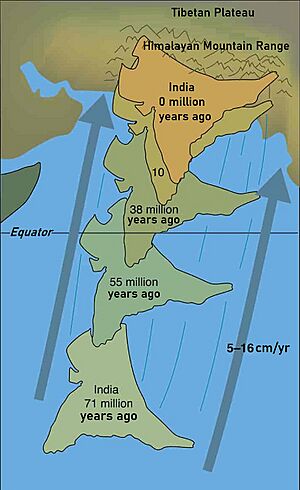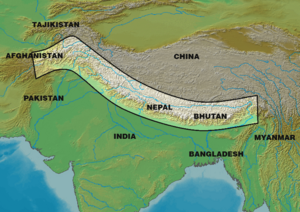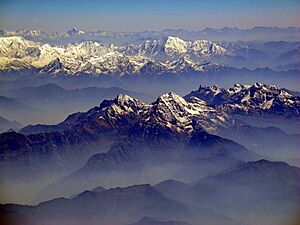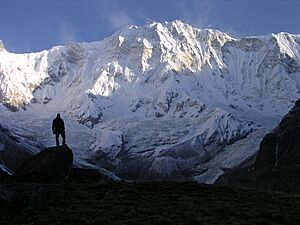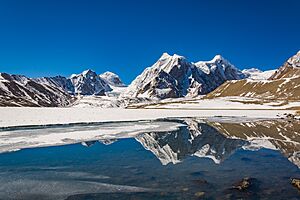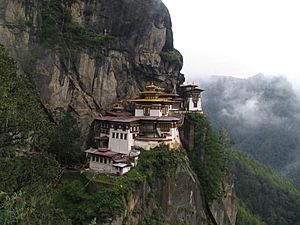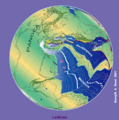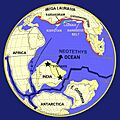Himalayas facts for kids
Quick facts for kids The Himalayas |
|
|---|---|
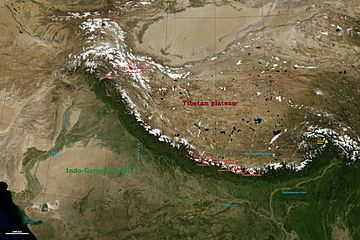
The arc of the Himalayas (also Hindu Kush and Karakorams) showing the eight-thousanders (in red); Indo-Gangetic Plain; Tibetan plateau; rivers Indus, Ganges, and Yarlung Tsangpo-Brahmaputra; and the two anchors of the range (in yellow)
|
|
| Highest point | |
| Peak | Mount Everest (Nepal, China) |
| Elevation | 8,848.86 m (29,031.7 ft) |
| Dimensions | |
| Length | 2,400 km (1,500 mi) |
| Geography | |
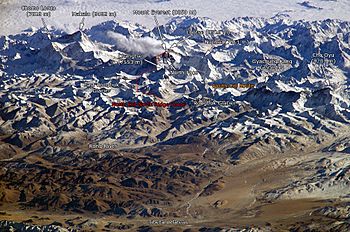
Mount Everest and surrounding peaks as seen from the north-northwest over the Tibetan Plateau. Four eight-thousanders can be seen, Makalu (8,462 m), Everest (8,848 m), Cho Oyu (8,201 m), and Lhotse (8,516 m).
|
|
| Countries | |
| Geology | |
| Orogeny | Alpine orogeny |
| Age of rock | Cretaceous to Cenozoic |
| Type of rock | |
The Himalayas are a massive mountain range in Asia, often called the "roof of the world." They separate the flat plains of the Indian subcontinent from the high Tibetan Plateau. This incredible range is home to many of the planet's tallest mountains, including the very highest, Mount Everest. With over 100 peaks soaring higher than 7,200 meters (23,600 feet), the Himalayas are a place of amazing natural beauty and home to a wide variety of plants and animals.
The Himalayas stretch across six countries: Nepal, China, Pakistan, Bhutan, India, and Afghanistan. The great rivers that start here, like the Indus, Ganges, and Brahmaputra, provide water to over 600 million people. The mountains have also had a big influence on the cultures of South Asia and Tibet. Many Himalayan peaks are considered sacred in Hinduism and Buddhism.
Contents
What's in a Name?
The name "Himalaya" comes from the ancient Sanskrit language. It is a combination of two words: hima, which means "snow," and ālaya, which means "home" or "dwelling." So, Himalaya literally means the abode of snow—a perfect name for a mountain range with so many snow-covered peaks. In many older books, the mountains are also called "the Himalaya."
How Were the Himalayas Formed?
Have you ever wondered how such giant mountains were made? The Himalayas were formed by a slow but powerful collision between two huge pieces of the Earth's crust, called tectonic plates.
Millions of years ago, the land that is now India was an island. It slowly drifted north until it crashed into the giant continent of Asia. Imagine two cars crashing in slow motion. As the Indian plate pushed under the Eurasian plate, the land in between had nowhere to go but up. It buckled and folded, creating the towering peaks we see today.
This process, called orogeny (mountain building), is still happening! The Indian plate continues to push into Asia, causing the Himalayas to grow a few millimeters taller every year. This movement also makes the region a place where earthquakes can happen.
A Tour of the Himalayas
The Himalayas stretch in a long arc for about 2,400 kilometers (1,500 miles). The range is so big that it's often divided into different sections.
The Eastern Himalayas
In the east, you'll find Kangchenjunga, the third-highest mountain in the world, on the border of Nepal and India. This area, which includes the country of Bhutan, has steep, forested valleys. The highest mountain in Bhutan is Gangkhar Puensum, which may be the highest unclimbed mountain in the world.
The Central Himalayas
This region, mostly in Nepal, is the most famous part of the Himalayas. It's home to eight of the world's ten highest mountains! This includes Mount Everest, Lhotse, and Annapurna. Kathmandu, the capital of Nepal, is located in a large valley south of these giant peaks. Many trekkers and climbers visit this area to see the world's highest mountains up close.
The Western Himalayas
As you move west into India and Pakistan, the landscape changes. This area includes the beautiful Kashmir Valley and famous peaks like Nanda Devi. The range ends in the west with the dramatic peak of Nanga Parbat in Pakistan. It is a massive mountain that rises steeply above the Indus River.
Water and Ice: The Lifeline of Asia
The Himalayas are not just tall mountains; they are also a massive storehouse of fresh water in the form of ice and snow.
Mighty Rivers
Some of Asia's most important rivers begin in or near the Himalayas. The Indus, the Ganges, and the Tsangpo-Brahmaputra all start their long journeys here. These rivers provide water for farming, drinking, and daily life for hundreds of millions of people in countries like India, Pakistan, and Bangladesh.
The World's 'Third Pole'
After the North and South Poles, the Himalayas contain the largest amount of ice and snow in the world. That's why the region is sometimes called the Third Pole. There are about 15,000 glaciers in the Himalayas. These glaciers are like slow-moving rivers of ice that store water from winter snows and release it slowly during the warmer summer months, feeding the great rivers.
High-Altitude Lakes
The Himalayan region is also filled with hundreds of beautiful lakes. Some, like Pangong Tso on the border of India and China, are very large. Others, like Tilicho Lake in Nepal, are famous for being among the highest lakes in the world. These lakes are often a stunning turquoise color because of the fine rock dust, called glacial flour, that is carried into them by melting glaciers.
Weather in the World's Highest Place
The climate in the Himalayas changes a lot depending on how high you are and which side of the mountains you are on. At the base of the mountains, the weather can be warm and tropical. But as you climb higher, it gets much colder. The highest peaks are covered in snow and ice all year round.
The most important weather feature is the monsoon. During the summer, warm, wet winds from the Indian Ocean blow towards the Himalayas. When these winds hit the mountains, they are forced to rise, cool down, and release their moisture as heavy rain. This brings a lot of rain to the southern side of the range.
The northern side of the Himalayas, however, is very dry. The high mountains block the monsoon clouds, creating a rain shadow. This means places like the Tibetan Plateau get very little rain and have a cold, desert-like climate.
Amazing Wildlife and Plants
The Himalayas are a biodiversity hotspot, which means they are home to a huge variety of life, much of which is not found anywhere else on Earth.
Animals of the Mountains
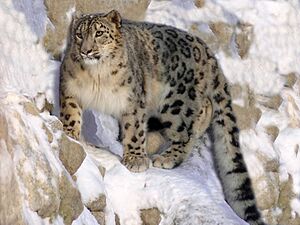
Many unique animals have adapted to life in the mountains. At high altitudes, the rare and beautiful snow leopard hunts for prey like the bharal (blue sheep). The Himalayan musk deer and the shaggy-haired Himalayan tahr also live on the rocky slopes.
In the forests of the eastern Himalayas, you might find the adorable red panda, which mostly eats bamboo. Lower down, in the foothills, live different kinds of monkeys, like the Gee's golden langur.
From Tropical Forests to Icy Peaks
The plant life in the Himalayas changes dramatically with altitude.
- The foothills have lush subtropical forests with many types of trees and flowers.
- As you go higher, you enter temperate forests of oak, pine, and rhododendron trees. In the spring, the rhododendron forests burst into bright red and pink flowers.
- Even higher up, the trees disappear, and you find alpine meadows with tough grasses and small, colorful flowers that bloom in the short summer.
- At the very highest elevations, only the hardiest plants like moss and lichen can survive on the rocks near the snow line.
A Sacred Place
For thousands of years, the Himalayas have been a very important spiritual place for several religions, especially Hinduism and Buddhism.
Many peaks are considered to be the homes of gods and goddesses. For Hindus, the Himalayas are the home of the god Shiva, and the goddess Parvati is known as the "Daughter of the Mountain." The holy Ganges river is also believed to start its journey from the Himalayan glaciers.
For Buddhists, many important monasteries are nestled in the mountains. Paro Taktsang, or the "Tiger's Nest" monastery, clings to a cliffside in Bhutan and is a famous holy site.
Because of their religious importance, some mountains are considered too sacred to be climbed. Peaks like Mount Kailash in Tibet and Machapuchare in Nepal are off-limits to climbers to show respect for local beliefs.
A Changing Environment
Like many places on Earth, the environment of the Himalayas is changing. The global climate is getting warmer, and this has a big effect on the mountains.
One of the biggest concerns is that the glaciers are melting faster than before. Since these glaciers feed the major rivers of Asia, this could affect the water supply for millions of people in the future. Faster melting can also cause large mountain lakes to overflow, leading to dangerous floods.
These changes also affect the people and animals living in the Himalayas. Farmers are finding that weather patterns are less predictable, which makes it harder to grow crops. To deal with these challenges, local communities are finding new ways to adapt. They are planting different types of crops that can handle the new conditions and building walls to protect their villages from landslides and floods.
See also
 In Spanish: Himalaya para niños
In Spanish: Himalaya para niños
- Eastern and Western Himalaya
- Indian Himalayan Region
- List of Himalayan peaks and passes
- List of Himalayan topics
- List of mountains in India, Pakistan, Bhutan, Nepal and China
- List of Ultras of the Himalayas
- Trekking peak
Images for kids
-
The Marsyangdi valley with Annapurna II in the background.
-
The Imja Khola river valley in the Solukhumbu region of Nepal.
-
The Gandaki River flowing through a valley in Nepal.
-
A caravan of yaks, which are used to carry goods in the high mountains.
-
A male Himalayan tahr, a type of wild goat found in the Himalayas.
-
The Red panda lives in the bamboo forests of the eastern Himalayas.
-
The Garhwal Himalayas in the Indian state of Uttarakhand.
-
Harmukh is a sacred mountain for Hindus in the Kashmir Valley.


